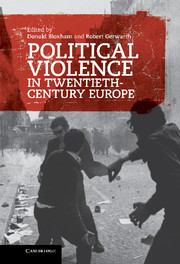15 results
2 - The Murder of European Jewry
- from Part I - Comparative and Historical Perspectives
-
-
- Book:
- Beyond the Racial State
- Published online:
- 10 November 2017
- Print publication:
- 16 November 2017, pp 58-94
-
- Chapter
- Export citation
8 - War crimes trials
- from Part I - Ideologies
-
-
- Book:
- The Cambridge History of the Second World War
- Published online:
- 05 June 2015
- Print publication:
- 23 April 2015, pp 181-208
-
- Chapter
- Export citation
Contributors
-
-
- Book:
- The Cambridge History of the First World War
- Published online:
- 05 December 2013
- Print publication:
- 09 January 2014, pp xv-xvi
-
- Chapter
- Export citation
22 - Genocide
- from Part IV - Rules of Engagement, Laws of War and War Crimes
-
-
- Book:
- The Cambridge History of the First World War
- Published online:
- 05 December 2013
- Print publication:
- 09 January 2014, pp 585-614
-
- Chapter
- Export citation
3 - Genocide and ethnic cleansing
-
-
- Book:
- Political Violence in Twentieth-Century Europe
- Published online:
- 05 June 2012
- Print publication:
- 10 March 2011, pp 87-139
-
- Chapter
- Export citation

Political Violence in Twentieth-Century Europe
-
- Published online:
- 05 June 2012
- Print publication:
- 10 March 2011
1 - Europe in the world: systems and cultures of violence
-
-
- Book:
- Political Violence in Twentieth-Century Europe
- Published online:
- 05 June 2012
- Print publication:
- 10 March 2011, pp 11-39
-
- Chapter
- Export citation
Contents
-
- Book:
- Political Violence in Twentieth-Century Europe
- Published online:
- 05 June 2012
- Print publication:
- 10 March 2011, pp vii-vii
-
- Chapter
- Export citation
Index
-
- Book:
- Political Violence in Twentieth-Century Europe
- Published online:
- 05 June 2012
- Print publication:
- 10 March 2011, pp 249-258
-
- Chapter
- Export citation
Frontmatter
-
- Book:
- Political Violence in Twentieth-Century Europe
- Published online:
- 05 June 2012
- Print publication:
- 10 March 2011, pp i-vi
-
- Chapter
- Export citation
Introduction
-
-
- Book:
- Political Violence in Twentieth-Century Europe
- Published online:
- 05 June 2012
- Print publication:
- 10 March 2011, pp 1-10
-
- Chapter
- Export citation
Notes on contributors
-
- Book:
- Political Violence in Twentieth-Century Europe
- Published online:
- 05 June 2012
- Print publication:
- 10 March 2011, pp viii-x
-
- Chapter
- Export citation
Notes
-
- Book:
- Political Violence in Twentieth-Century Europe
- Published online:
- 05 June 2012
- Print publication:
- 10 March 2011, pp 210-248
-
- Chapter
- Export citation
Beyond ‘Realism’ and Legalism: A Historical Perspective on the Limits of International Humanitarian Law
-
- Journal:
- European Review / Volume 14 / Issue 4 / October 2006
- Published online by Cambridge University Press:
- 08 September 2006, pp. 457-470
-
- Article
- Export citation
British War Crimes Trial Policy in Germany, 1945–1957: Implementation and Collapse
-
- Journal:
- Journal of British Studies / Volume 42 / Issue 1 / January 2003
- Published online by Cambridge University Press:
- 21 December 2012, pp. 91-118
- Print publication:
- January 2003
-
- Article
- Export citation



